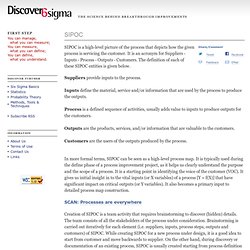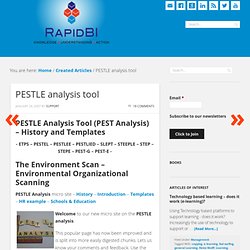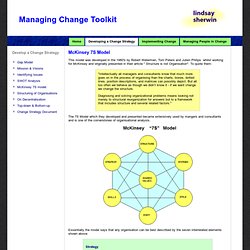

Objectives. Rules. Change Management using ADKAR. The ADKAR model is a results-oriented change management tool that is simple and easy to understand, yet very effective for managers and change management teams.

We receive more calls for information about this model than any other. It is used as a resistance management tool, an assessment device and to help change management teams organize their work. SWOT. Stakeholders. NHS Quality and service improvement tools. The Change Curve - Change Management Training from MindTools. Accelerating Change, and Increasing its Likelihood of Success © Veerdarrenbaker Change can be both daunting and exciting.

Here's the scenario: You have invested vast amounts of time and dollars in the latest systems and processes; you have trained everyone; and you have made their lives so much easier (or so you think.) Yet months later, people still persist in their old ways. Where are the business improvements you expected? The fact is that organizations don't just change because of new systems, processes or structures. As someone needing to make changes within your organization, the challenge is to help and support people through these individual transitions, which can sometimes be intensely traumatic, and involve loss of power and prestige... and even employment. The easier you can make this journey for people, the sooner your organization will benefit, and the more likely you are to be successful. Here, we look first at the theory behind the Change Curve. Note 1: Note 2: Tip: Stage 1. Presentation Tools. The New Change Managment. Scrum%20for%20Change%20Management. SIPOC. SIPOC - Discover 6 Sigma - Online Six Sigma Resources.
SIPOC is a high-level picture of the process that depicts how the given process is servicing the customer.

It is an acronym for Suppliers - Inputs - Process - Outputs - Customers. The definition of each of these SIPOC entities is given below. Suppliers provide inputs to the process. SIPOC Diagram. Kerri Simon February 26, 2010 Many recent inquiries and discussions have focused on the SIPOC diagram – a tool used in the Six Sigma methodology.

Because of the interest level, a further explanation is presented here along with a sample and template for your use. A SIPOC diagram is a tool used by a team to identify all relevant elements of a process improvement project before work begins. It helps define a complex project that may not be well scoped, and is typically employed at the Measure phase of the Six Sigma DMAIC (Define, Measure, Analyze, Improve, Control) methodology. It is similar and related to process mapping and ‘in/out of scope’ tools, but provides additional detail. Project Scoping in Healthcare: An Exploration and Tips.
An important factor contributing to the success of a Six Sigma healthcare project is the initial defining or scoping of the project.

After the primary focus area of a project has been identified, scoping is the activity of breaking down the focus area into the many specific processes, sub-divisions of the business and/or segments that drive the performance of the focus area. It is done by Black/Green Belts with assistance from a Master Black Belt and the focus area Sponsor. Scoping can uncover multiple potential processes requiring improvement.
Force Field Analysis (Forcefield Analysis) - Decision-Making Skills Training from MindTools. Analyzing the Pressures For and Against Change How to use Force Field Analysis, with James Manktelow & Amy Carlson.

Force Field Analysis is a useful decision-making technique. It helps you make a decision by analyzing the forces for and against a change, and it helps you communicate the reasoning behind your decision. Baulcomb (2003) Managing Change through Force_Field_Analysis. PEST. Pest variations The PEST model, like most very good simple concepts, has prompted several variations on the theme.

For example, the PEST acronym is sometimes shown as STEP, which obviously represents the same factors. Stick with PEST - nearly everyone else does. More confusingly (and some would say unnecessarily) PEST is also extended to seven or even more factors, by adding Ecological (or Environmental), Legislative (or Legal), and Industry Analysis, which produces the PESTELI model. PEST/ PESTLE Analysis. PESTLE Analysis Tool (PEST Analysis) – History and Templates The Environment Scan – Environmental Organizational Scanning PESTLE Analysis micro site – History – Introduction – Templates – HR example – Schools & Education Welcome to our new micro site on the PESTLE analysis.

This popular page has now been improved and is split into more easily digested chunks. Lets us know your comments and feedback. McKinsey 7S Model. This model was developed in the 1980's by Robert Waterman, Tom Peters and Julien Philips whilst working for McKinsey and originally presented in their article " Structure is not Organisation".

To quote them: "Intellectually all managers and consultants know that much more goes on in the process of organising than the charts, boxes, dotted lines, position descriptions, and matrices can possibly depict. But all too often we behave as though we didn’t know it - if we want change we change the structure. Diagnosing and solving organizational problems means looking not merely to structural reorganization for answers but to a framework that includes structure and several related factors.
" The 7S Model which they developed and presented became extensively used by mangers and consultants and is one of the cornerstones of organisational analysis.